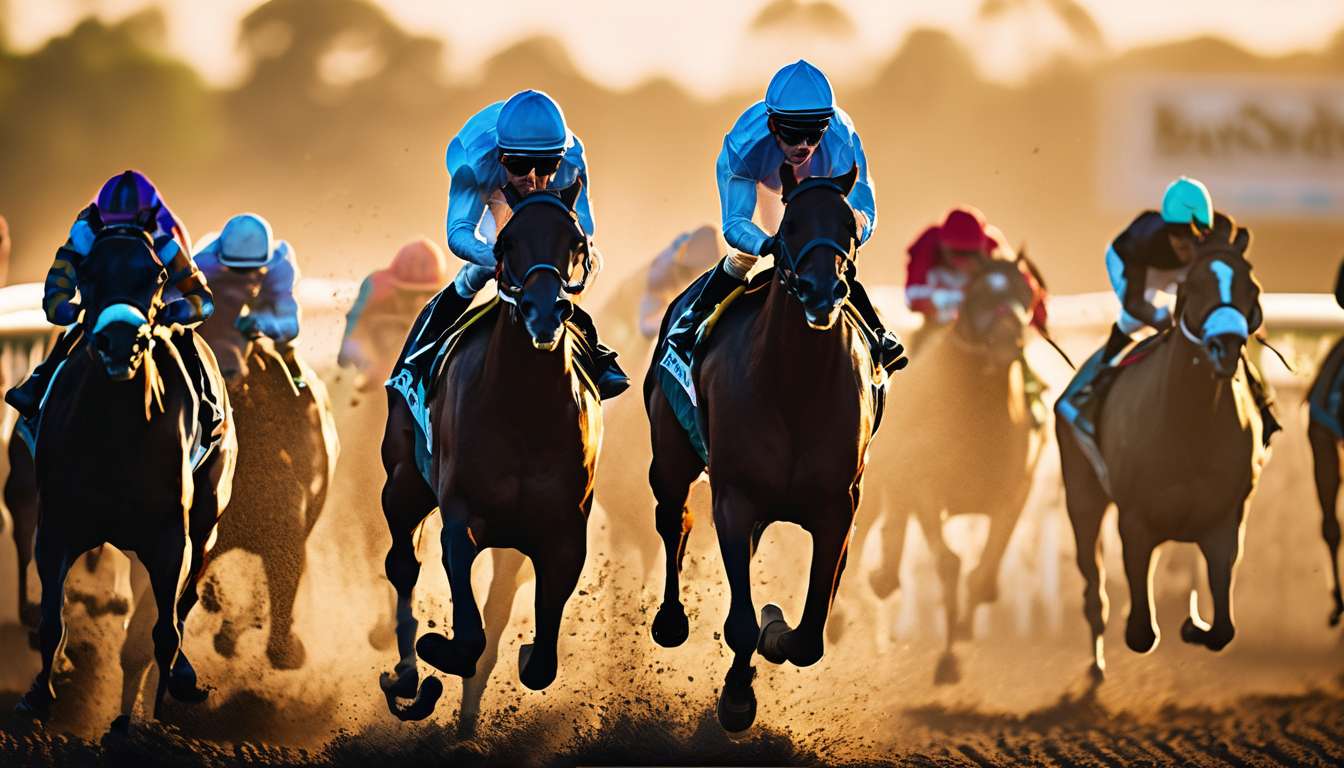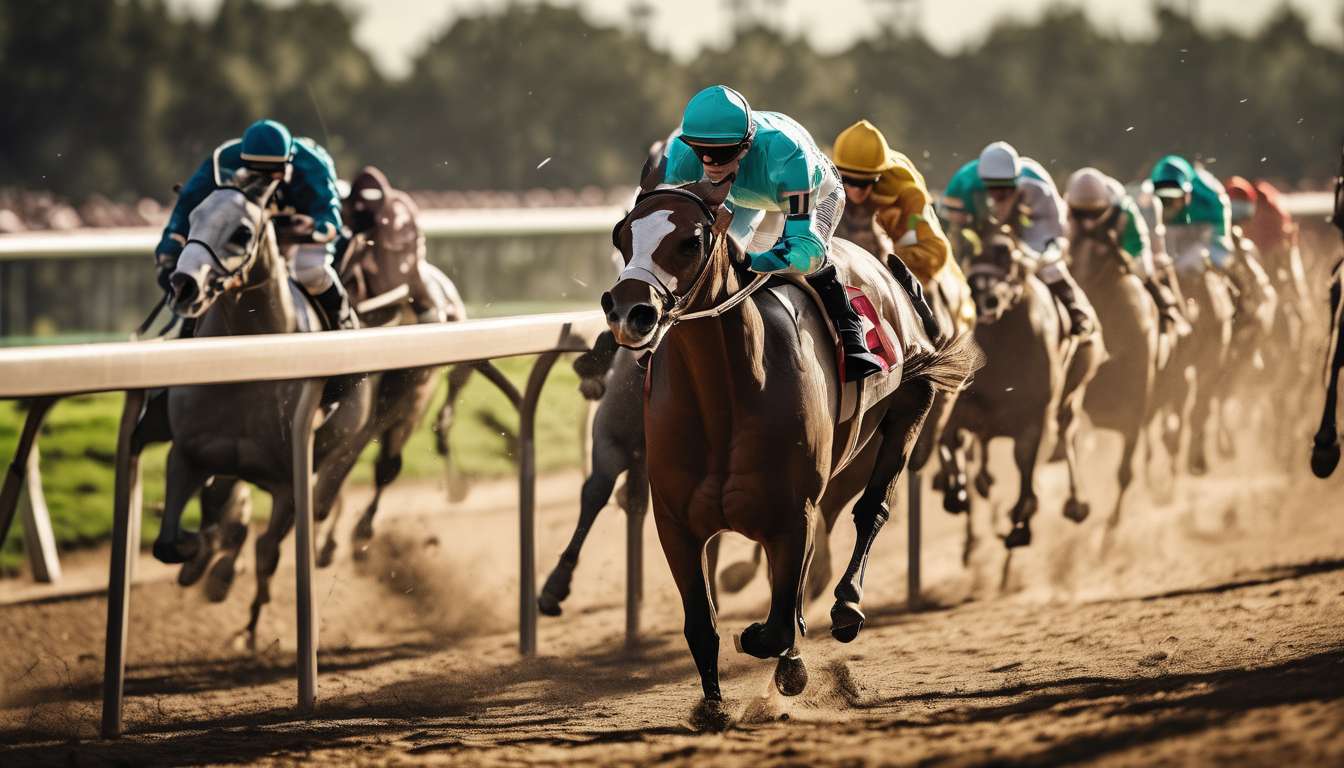As seasoned bettors, we understand that the thrill of horse racing extends far beyond the excitement of the track. There’s an art to placing the right bet, and a crucial component of that art is understanding track conditions.
Recognizing Track Conditions:Understanding how different track conditions affect a horse’s performance can provide the edge needed to make smarter wagers. Each weathered surface, from muddy slogs to sun-baked turf, tells a story that influences the race’s outcome.
In this article, we explore the top 10 track conditions every bettor should know, drawing from our collective experience and insights to enhance our betting strategies:
-
Fast Track
- A dry and firm surface ideal for speed.
-
Good Track
- Slight moisture but still provides a good grip for horses.
-
Muddy Track
- A wet, heavy surface that can slow down the race.
-
Sloppy Track
- Very wet with puddles; may favor horses that excel in wet conditions.
-
Wet Fast Track
- Appears wet but is compacted and fast.
-
Yielding Turf
- Soft and wet turf that may slow down horses accustomed to firm surfaces.
-
Soft Turf
- More moisture than yielding turf, demanding greater stamina from horses.
-
Firm Turf
- The driest and fastest turf condition.
-
Heavy Track
- Extremely wet and boggy, greatly affecting speed and performance.
-
Frozen Track
- Hard and unforgiving surface, often impacting traction.
By the end of this exploration, we aim to equip ourselves with the knowledge needed to navigate the complex world of racing tracks. This understanding will ultimately boost our confidence and success at the betting window.
Fast Track
A fast track typically means that the racing surface is dry and hard, allowing horses to achieve their maximum speed. As fellow horse racing enthusiasts, understanding track conditions is crucial to crafting a winning betting strategy.
When the track is fast, it gives us the chance to analyze races differently. Horses that prefer and excel on these surfaces can show their true potential, making it easier to identify strong contenders.
Our shared love for horse racing drives us to seek that edge, and recognizing a fast track is a vital part of it. We need to consider how each horse has performed under similar conditions previously.
Some horses thrive on fast tracks, while others might struggle. By examining:
- Past performances
- Track conditions
we can make smarter bets.
Let’s focus on building our strategy together, learning from each race, and sharing insights. In this way, we’re not just spectators; we’re part of a community, united by our passion for the sport.
Good Track
A good track offers a slightly softer surface than a fast track, requiring us to adapt our analysis based on how horses perform under these more forgiving conditions. As a community of horse racing enthusiasts, we recognize that track conditions can significantly impact race outcomes.
A good track necessitates refining our betting strategy because some horses excel on this slightly cushioned surface, demonstrating their stamina and adaptability.
To be among successful bettors, we should:
- Pay attention to a horse’s past performances on good tracks.
- Analyze these performances to identify patterns and make informed predictions.
Horses that thrive on good tracks often display:
- A balanced stride
- A steady pace
These are crucial indicators when placing bets.
Let’s support each other by sharing insights and experiences, enhancing our collective understanding of how good track conditions influence races.
Together, we can develop strategies that align with the nuances of horse racing, ensuring we’re always prepared for success.
Muddy Track
Adapting to Muddy Track Conditions
On a muddy track, it’s essential to adapt our analysis quickly, as these unpredictable conditions can significantly alter a horse’s performance. When the track conditions become muddy, true horse racing enthusiasts understand that their usual betting strategies might need a rethink. Muddy conditions can pose challenges even to seasoned horses, with some thriving and others struggling under these demanding circumstances.
Spotting Hidden Gems
By identifying which horses excel in muddy conditions, we become part of a community that knows how to spot hidden gems. Incorporating past performance data on muddy tracks into our betting strategy is crucial. This involves:
- Reviewing a horse’s previous races in similar conditions.
- Anticipating its potential in current races based on past performances.
Community and Shared Insights
This knowledge unites us, creating a shared understanding of the nuances that impact outcomes on race day. Staying connected and discussing insights allow us to make informed decisions together. By doing so, we:
- Strengthen our bonds as a community.
- Enhance our chances of achieving success on muddy tracks.
Let’s continue to share knowledge and insights to improve our betting strategies and outcomes.
Sloppy Track
Sloppy tracks demand our immediate attention and adaptation, as they can drastically affect each horse’s ability to perform. When the track conditions are sloppy, the surface is wet and muddy, creating an entirely different dynamic in horse racing.
Adjusting our betting strategy is crucial, as not all horses handle sloppy conditions well. In these situations, we need to:
- Focus on horses with proven track records in similar conditions.
- Identify horses with a natural affinity for wet surfaces.
- Examine past performances on similar tracks to gain valuable insights.
As a community of bettors, we thrive on shared information and experiences. Discussing these factors with fellow enthusiasts can:
- Strengthen our understanding.
- Improve our strategies.
Together, we can better predict outcomes and make informed decisions.
Remember, adapting quickly to these track conditions can be the key to successful betting and a more rewarding horse racing experience.
Wet Fast Track
A wet fast track can offer unique opportunities because it combines the speed of a dry surface with the unpredictability of moisture. This intriguing track condition presents the challenge of crafting a clever betting strategy.
In horse racing, the wet fast track is a rare gem. The surface retains its firmness, yet a thin layer of moisture adds an element of surprise.
Exploring Successful Horses:
- Horses that thrive on fast tracks typically perform well on wet fast tracks.
- Consider horses with a proven record on wet surfaces.
By analyzing past performances and understanding the nuances of wet fast tracks, we can strengthen our sense of community and shared purpose.
Embracing the thrill of the unpredictable, we become part of a knowledgeable group, united by our love for horse racing and our quest to master the ever-changing track conditions. Let’s seize these moments and refine our betting strategies together.
Yielding Turf
Yielding turf presents a unique challenge as the softer ground can dramatically alter a horse’s performance and the outcome of a race. As bettors, we must adapt our betting strategy to the nuances of these track conditions.
Key Considerations:
- Horses with a strong track record on firm turf might struggle on yielding ground.
- Focus on horses that have shown resilience in softer conditions.
Analyzing Past Performances:
- Pay attention to races run on yielding tracks.
- Identify horses that exhibit strong finishes in these conditions, as they are likely to excel again.
- Consider jockeys who have a knack for navigating the complexities of yielding turf, as their experience can make a significant difference.
Community Strategy:
- Share insights and build strategies to increase our chances of success.
- Understand how yielding turf affects races to make more informed bets.
By embracing this challenge, we can turn it into an opportunity for our betting community. Let’s work together to leverage our collective knowledge and enhance our betting strategies.
Soft Turf
Soft Turf Challenges in Horse Racing
Soft turf tests our analytical skills as it requires us to consider how the moisture-laden ground affects each horse’s performance. In horse racing, these track conditions bring unique challenges and opportunities.
Key Considerations:
- Horses with a history of excelling in softer tracks may gain an edge.
- It is vital to review past performances to identify such horses.
- Analyzing jockey strategies is essential to understand how they adapt to these conditions.
Betting Strategy on Soft Turf:
-
Focus on Stamina:
- Prioritize horses with strong stamina.
- Look for horses proven in similar track conditions.
-
Trainer Preparations:
- Consider how trainers prepare their horses for variability in track conditions.
-
Community Insights:
- Network with fellow bettors for insights that might not be evident in racing forms.
- Sharing experiences and strategies creates a sense of community.
Conclusion:
Together, we can turn soft turf challenges into rewarding betting experiences, enhancing our understanding and enjoyment of the sport. Let’s embrace the complexities and bet smartly!
Firm Turf
Firm turf presents a unique set of opportunities and challenges that require us to adapt our betting strategies accordingly. As horse racing enthusiasts, we understand that track conditions can greatly influence race outcomes. Firm turf, known for its hard and fast surface, often favors horses with a natural speed advantage. When we analyze these races, it’s crucial to consider horses with strong records on similar surfaces.
Key Considerations for Betting on Firm Turf:
- Horse Performance: Focus on horses that have shown strong performances on firm turf in the past.
- Pedigree Analysis: Horses with turf-friendly lineage often excel on firm turf, making pedigree analysis a valuable tool.
- Weather Conditions: Stay alert to weather changes, as sudden rain can transform firm turf into a softer track, which may require a change in strategy.
Community Insights:
Our community thrives on shared insights and experiences. Discussing past performances and breeding lines becomes essential for making informed decisions. Incorporating these strategies into our betting ensures we’re not just spectators but active participants in the thrill of horse racing.
Embrace the Camaraderie:
Let’s embrace the camaraderie of shared knowledge and refine our approach to firm turf together. By doing so, we enhance our overall experience and success in horse racing.
What are the key differences between synthetic track conditions and natural track conditions?
Key Differences Between Synthetic and Natural Track Conditions
Synthetic Tracks:
- Typically made from materials like polytrack or Tapeta.
- Provide a consistent surface regardless of weather conditions.
Natural Tracks:
- Made of dirt or turf.
- Condition can vary based on factors such as:
- Rain
- Maintenance
Importance of Understanding Track Conditions
Understanding these distinctions can help us make more informed betting decisions based on the track conditions.
How does weather impact the maintenance schedule of a racetrack?
Weather’s Role in Racetrack Maintenance
Weather is a critical factor in determining the timing of racetrack maintenance. It influences the track’s surface conditions and overall performance.
Impact of Weather Conditions:
-
Rain: Leads to softer surfaces, which can reduce track grip and cause delays in scheduled maintenance work.
-
Extreme Heat: Causes the track to dry out quickly, necessitating additional watering to maintain optimal conditions.
Importance of Monitoring:
By closely monitoring weather conditions, we can adjust our maintenance schedule effectively. This ensures the track remains in optimal condition, prioritizing both safety and performance.
Are certain horse breeds better suited for specific track conditions?
Certain horse breeds excel in specific track conditions.
Thoroughbreds often perform well on fast tracks due to their speed and agility.
In contrast, Standardbreds are known for their endurance and may fare better on tracks with more grip, like a good surface.
By understanding these nuances, we can make more informed betting decisions based on which breeds are better suited for the prevailing track conditions.
Conclusion
Now that you’re familiar with the top 10 track conditions, you’ll be better equipped to make informed betting decisions.
Remember to:
-
Keep an eye on the weather: Weather changes can significantly affect track conditions, influencing the performance of horses.
-
Monitor track conditions: Know how different conditions can impact race outcomes to make strategic bets.
By staying informed, you can maximize your chances of success.
Happy betting!




